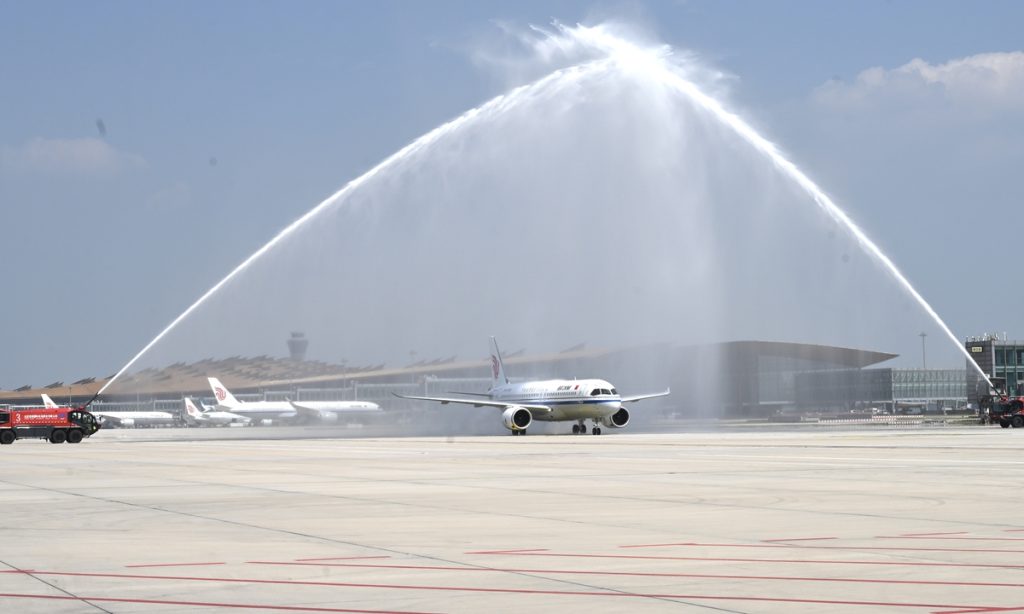Two C919 planes land in Beijing, Guangzhou, as Air China, China Southern Airlines prepare for commercial flights

At 11:23 am on Thursday, a round of applause erupted in Air China's first C919 cabin, when the home-made plane, with the registration number of B-919X, landed smoothly at the Beijing Capital International Airport in Beijing.
Welcomed with a water cannon salute at the airport, Air China's first C919 aircraft officially joined the fleet.
About one hour earlier, another C919 received by China Southern Airlines landed at Guangzhou Baiyun International Airport in Guangzhou, South China's Guangdong Province, also becoming the first of its kind received by China Southern.
It is the second day after the single-aisle C919 were delivered to the two major Chinese air carriers by the Commercial Aircraft Corporation of China (COMAC) in Shanghai. The aircraft have now returned to their bases, preparing for future service.
The C919 is an excellent aircraft, achieving a very high standard in design, performance, as well as in terms of control feeling and human-computer interaction, Wang Yan, the captain of Air China B-919X, told the Global Times on Thursday.
"I am proud of the Air China C919 aircraft, and I am proud to be a C919 pilot," Wang said.
Wang has long flown Boeing 777 and Airbus 321 aircraft. In July, Wang completed the C919 modification training and obtained a new pilot license.
"We will ensure that domestically-produced large aircraft fly smoothly in the blue sky, prioritizing safety and efficiency," Wang said.
The most striking feature of Air China's C919 is its spaciousness, including the wide aisle, an open cabin layout, and generous seat spacing.
Air China's C919 aircraft has a total of 158 seats, including eight business class seats with a pitch of 40 inches, 150 economy class seats with a pitch of 30-31 inches, and a 45-inch pitch at the safety exit.
Compared with other airlines, which have 164 seats, Air China has one fewer row of economy class seats, so the distance between each row of seats is increased by two inches. The seat spacing is better than that of similar foreign planes.
While seated in an economy class seat, the GT reporter opened the tray table and placed a laptop on it without feeling cramped, while the leg space was comfortable. When the passenger in the middle seat leaves the seat, another passenger does not need to stand up, but can easily make room by turning slightly sideways.
Even if the flight attendants push the dining cart down the central aisle, there is relatively ample space in the aisle on both sides, the reporter noticed.
To ensure safety, Air China set up a flying team for C919, and the first group of ten C919 pilots completed the transition training on July 29 and passed the test organized by the Civil Aviation Administration of China, all with excellent results, receiving their C919 pilot licenses.
Information shared by China Southern showed that the carrier selected three experienced captains, with a total flight time exceeding 35,000 hours.
China Southern said it will launch a route from Guangzhou to Shanghai on September 19. The carrier said it has been deepening cooperation with COMAC in maintenance capability development, parts manufacturing, and aircraft monitoring system to ensure the safe and efficient operation of the C919.
The carrier independently develops an aircraft health management system, the only one in the world compatible with Boeing, Airbus, and the home-made aircraft. It can provide real-time status monitoring, fault diagnosis, and predictive maintenance, and data-driven decision support to improve aircraft safety, reliability and maintenance efficiency.
China Southern announced that it plans to implement the system across all C919 fleet after successful testing.
Currently, a total of nine C919 planes have been delivered to airlines by COMAC. Among them, the C919 aircraft of China Eastern Airlines, the first global user, has been operating smoothly for 15 consecutive months since its first commercial flight, flying five routes, and has completed more than 3,600 commercial flights and 10,000 flight hours.